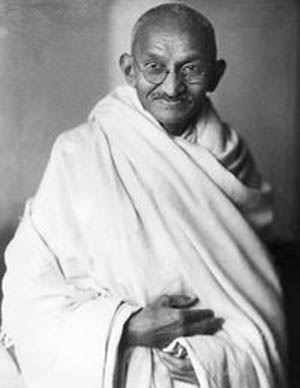 |
Mohandas Karamchand Gandhi was born on October 2, 1869, in Porbandar, a small state in western India. Gandhi was born into a middle class family who were cultured and deeply religious Hindus, and through this family he learned the traits and ideals that shaped Gandhi and the life he made for himself.
Gandhi’s childhood was that of a typical middle-class Indian child despite the many difficulties he had with learning. At age six Gandhi was enrolled at Porbandar, an elementary school where he continued to prove a mediocre student. Other than Gandhi’s education, he had a fairly uneventful childhood until his early teen years. When Gandhi was thirteen his parents forced Gandhi into an arranged marriage, having hardly known his future wife their relationship was at times awkward and both himself and his wife Kasturbai were shy towards one another. During his years of schooling he was able to improve and raised his standards, Gandhi carried onto high school.
As the years passed Gandhi grew into a rebellious and desperate teenager and resorted to stealing from his own family. Gandhi needed money and he grew desperate, he stole a bit of gold jewelry from his brother to pay for his own selfish needs. Even though Gandhi intentionally committed the crime, he felt more and more guilty as time went on. After he had stolen the jewelry he could no longer handle the guilt he felt when his brother would mention the missing items, Gandhi confessed his crime and his feelings to his father. Gandhi had originally expected his father to be furious, maybe even aggressive, but, he was surprised by his father’s reaction, his father began to cry, his father was disappointed but moved by his genuine regret. Gandhi later reflected on this, he said "Those pearl drops of love cleansed my heart, and washed my sin away." It was his first insight into the impressive psychological power of ahimsa, or nonviolence.
Gandhi traveled to South Africa during the time of the apartheid, while in South Africa he experienced the cruelties of the apartheid system and founded his beliefs on fighting with non-violence. While in South Africa, Gandhi organized protests, marches and boycotts with one simple goal, peace and equality through non-violence. Gandhi later made a small colony made up of abused Indian laborers that learned to live off the land, refusing to be a part of the city life therefore taking workers from job sites and customers from apartheid governed stores. As the colony grew, so did Gandhi’s ideals and teachings. Even though Gandhi’s methods were nonviolent, he posed a serious threat to the apartheid system and was jailed without bail or even a legitimate charge multiple times. Gandhi fought his war without weapons or hate, and his methods proved more effective than any army or any weapon.
The main idea of Gandhi’s teachings is non-violence; he believed the killing of humans is an unforgivable sin, meaning there is no just cause to inflict physical pain towards another person. Gandhi also strongly disagreed with the caste system according to Hinduism; the caste system lies in respect for one another’s individuality. Gandhi fought any and all forms of injustice and oppression with non-compliance and non-violent methods.
His beliefs are simple; he believes in peace and unity that violence is not the answer and Gandhi stood for these ideals through his last breath. Gandhi endured brutal punishment, pain, discrimination and both physical and mental torture but never once fought back with violence, never raised a fist in anger. Gandhi’s message was simple but effective. During the time of apartheid in South Africa, Gandhi fought for the rights of the Indians, blacks and other minorities living under the white’s oppression. Gandhi believed there is a peaceful solution for every problem and therefore he fought nonviolently by organizing protests, boycotts, marches and other forms of civil disobedience. Gandhi’s fight against apartheid began shortly after traveling to South Africa where he experienced racial discrimination for the first time. While Gandhi was aboard a train to head to Johannesburg, South Africa, a white man entered Gandhi’s cart and demanded that Gandhi give up his seat and move to the third class seating. Gandhi refused to move and was eventually thrown off the train by guards. This first encounter with South African apartheid made Gandhi the man he was, this incident convinced him to join and in some ways lead the fight against white oppression. In 1894, shortly after entering South Africa Gandhi’s efforts lead to him founding the Natal Indian Congress, the NIC fought for the rights of Indian traders living in South Africa and during this time Gandhi began teachings his methods of nonviolence and civil disobedience. In 1903 Gandhi and the NIC created the Indian Opinion, a weekly newspaper that the NIC typed up, translated, and printed out to its subscribers recapping on recent laws and political and racial news. The Indian Opinion was a way for Gandhi and his followers to express themselves and reach out to other Indians living in the community; during its existence the newspaper had an average of 2000 subscribers. Gandhi continued to organize marches to various locations demanding that their dwindling rights be returned, increased and protected. In 1914 the South African government acknowledged Gandhi’s demands and abolished unfair taxes on the Indian community and gave Indians the right to marriage. Overall Gandhi’s efforts in South Africa paid off, the apartheid system was still in place but he achieved his goals. "Gandhi in South Africa." Encounter South Africa. Encounter South Africa Magazine, Web. 17 Feb. 2010.Page created on 3/8/2010 12:00:00 AM
Last edited 3/8/2010 12:00:00 AM
